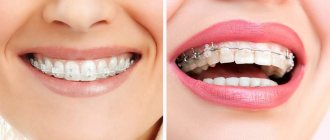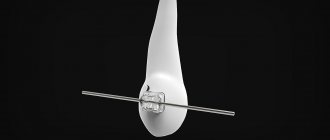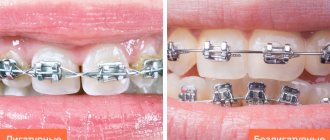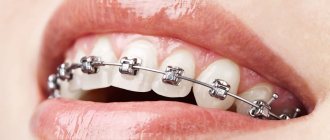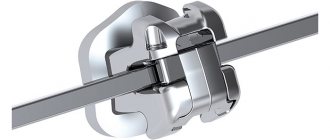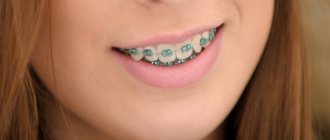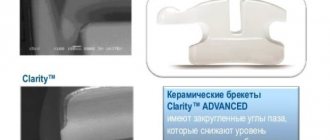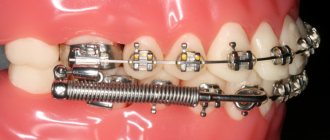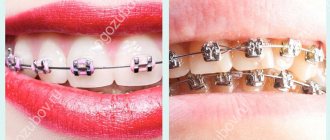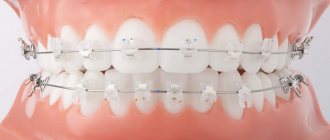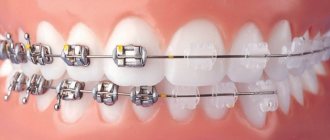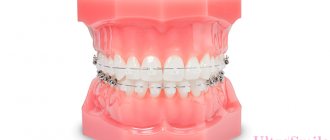Metal braces are considered the most common. They are very effective and are able to cope even with complex clinical cases. Modern metal braces are significantly different from their predecessors - low profile, small size, smoothed corners. Even special nickel-free designs have been developed for allergy sufferers.
Types of metal braces
Depending on the type of work, all metal braces are divided into ligature and self-ligating. In the first type, the plates are connected to the arch using ligatures, which can be either transparent or colored. These rings require replacement approximately once a month. The second type of system is distinguished by the absence of ligatures, which replace special latches. Self-ligating systems will appeal to those patients who are not inclined to frequent visits to the doctor, since they do not need to change the ligatures.
Metal structures are also vestibular and lingual. The first option is more common and has a reasonable price. Lingual systems are located on the inside of the teeth - near the tongue, and therefore are invisible to others.
Treatment
Treatment with metal braces takes quite a long time - from one to three years and includes several stages:
- preparatory: taking an X-ray or scanning the entire oral cavity to obtain a three-dimensional computer model of the jaw, excluding contraindications. In addition, they treat and remove diseased teeth, remove plaque and tartar;
- modeling and production of braces: they make a plaster model of the jaw, select a suitable system or make it specifically for the Patient, completely plan the treatment process;
- installation of braces: this procedure takes no more than two hours. Brackets are glued to each tooth and then connected with an arch.
- retention: securing the result obtained with the help of special devices - retainers. The duration of this stage is usually twice as long as the period of wearing braces.
Iron braces require careful hygiene and special care. It is necessary twice a day in the morning and evening, and also thoroughly clean hard-to-reach spaces after each meal. For these purposes, a special orthodontic toothbrush, brushes and mouthwash are used. Special attention is paid to nutrition: you should not eat too hard (nuts, candies) or viscous (chocolate, caramel) foods.
Damon (Ormco company)
Braces are very popular among patients. Often this is not very justified - due to advertising and fees for the brand itself, the cost of such systems is quite high. For the same price you can install more efficient devices. Today in clinics you can find the Q model with a low profile and an innovative latch (the systems work using self-ligating technology), as well as the 3MX (but they are of the old generation). When developing Damon systems, computerized technology is used, which ensures high efficiency of the system. The cost of installation on two jaws at once is from 70,000.
Contraindications
Contraindications to metal braces:
- allergy to metals;
- absence of a large number of teeth;
- diseases of the blood, cardiovascular system, mental, oncological, immune;
- children's age - as a rule, designs are recommended for installation no earlier than the complete change of the primary dentition to the permanent one, that is, after 12–14 years.
There are relative contraindications, such as periodontitis, periodontal disease, bruxism, and TMJ pathologies. But in this case, the decision to install is made on an individual basis after eliminating the underlying pathology.
Pilot (manufactured in Russia)
These braces are domestic, but are created in Chinese factories, due to which they have a very affordable price. Many orthodontists do not advise choosing these designs due to the outdated system and the inability to accurately predict treatment results. The cost of installation is from 6 to 10,000 per installation on one row of teeth.
Metal braces are the best option for patients who do not want to spend a lot on treatment and want to see results in the shortest possible time. It is these systems that are the most effective, according to experts, and allow one to cope even with complex pathologies.
How much are
Prices for metal braces in St. Petersburg vary widely. The final cost of treatment is determined by the type of bracket system, the amount of work required for installation, subsequent maintenance, and removal. Unplanned expenses may arise if the locks become unstuck or the arc breaks. The table shows the current minimum prices for equipment and services.
| Name | Cost of OT, rub. |
| Ligature system | 17000 |
| Mini | 14000 |
| Lingual braces | 80000 |
| Self-ligating bracket system | 21000 |
| Direct fixation | 3000 |
| Indirect fixation | 6000 |
| Taking an impression | 600 |
| Comprehensive diagnostics | 2500 |
| System activation | 2000 |
| Re-fixing the bracket | 450 |
| Replacing the lock | 1400 |
| Removing the bracket system | 3360 |
The price is for one jaw, without installation.
Truth or lie? Popular myths
Patients often believe myths that prevent them from achieving a beautiful and healthy smile. It is important to dispel such false statements:
1. “Metal braces look unsightly.” On the one hand, this statement is true. The metallic color and the bracket system itself attract the attention of others when talking. However, the dentist can offer lingual structures that remain completely invisible.
2. “Braces are only relevant for children.” Such beliefs are associated with the high prevalence of various correction methods among adolescents and schoolchildren. This is explained by the fact that the desire to have a beautiful smile is most in demand at a young age, and the treatment itself occurs faster during the period of active growth and mobility of teeth. However, a person should think about his well-being even after 30 years, because healthy and straight teeth are not only a beautiful smile, but also the condition of the entire body as a whole.
3. “The treatment is painful.” Partially, this is true. The patient may experience some discomfort after a power arch tightening. However, the unpleasant sensations last only 1-2 days, after which the jaw adapts to the new conditions. Pain and itching in the gums go away on their own and, in rare cases, require medication.
4. “Fixed metal structures damage the enamel, which means they negatively affect dental health.” Before attaching the locks to the enamel, the patient undergoes complete treatment of carious changes and extensive diagnostics of the strength of the enamel. Based on the data obtained, the dentist assesses the risks of complications. Healthy enamel can withstand the load of the structure without damage, and maintaining oral hygiene and following the doctor’s recommendations on nutrition eliminate the risk of caries in the areas of the tooth around the clasps.
To summarize, we can conclude that metal braces have many advantages. This is one of the most popular systems for correcting malocclusion. Moreover, their demand in the field of orthodontics is explained not only by their low cost, but also by the short treatment time, as well as the ability to correct complex defects.
Arcs
Unlike locks, arches are almost always made of durable metal. Only metal is capable of exerting the necessary pressure on the teeth and moving them in a given direction. In this case, the metal can be very different: high-quality stainless steel (SS), titanium combined with molybdenum (TMA), nickel with titanium (Ni-Ti), Copper combined with nickel and titanium (Cu Ni-Ti), etc. .
In this case, the choice is usually made not by the patient, but by the orthodontist based on many factors. First of all, it depends not on the patient’s desire, but on the degree of complexity of the defect he has. Each alloy has different characteristics, some are more flexible and some are less flexible.
Of course, an additional arc made of any alloy can be coated with a special coating. This will make the structure even less noticeable, this is especially true when installing sapphire and ceramic brackets. You can also cover it with gold, then the braces will look like real jewelry. The latter measure will protect the patient from an allergic reaction.
Find a similar case:
Back | ForwardDoctor: Sudzhaev Sergey Romanovich Patient's age: 22 years Diagnosis: crowding and retrusion of the frontal part of the upper and lower dentition. Vestibular position of teeth 1.3,2.3,3.3,4.3. Treatment period: 18 months Equipment: Smartclip SL3 bracket system
| BEFORE | STAGE (after 9 months) | AFTER |
